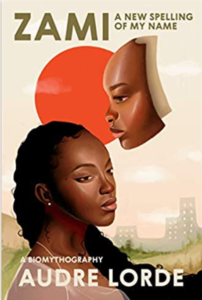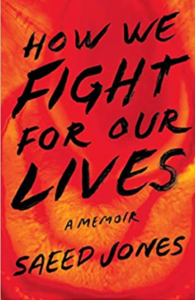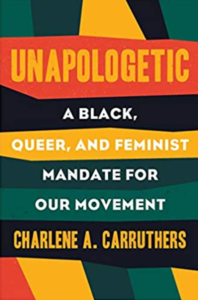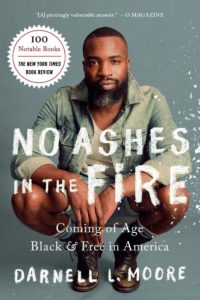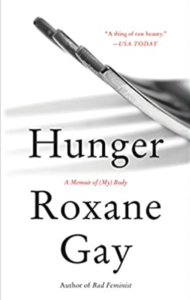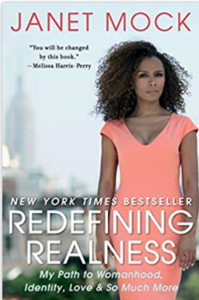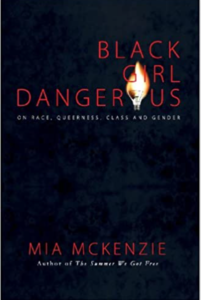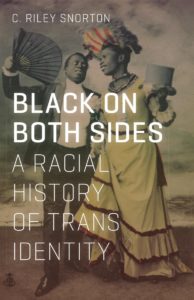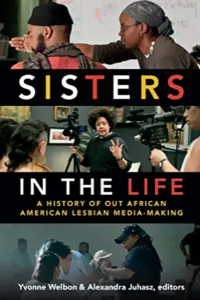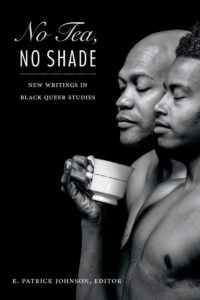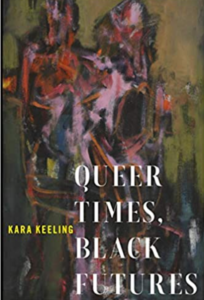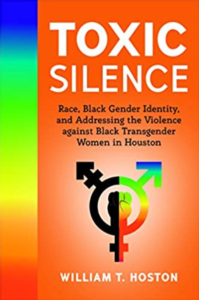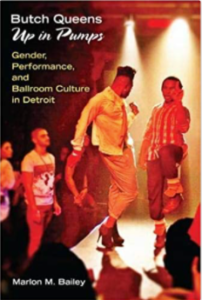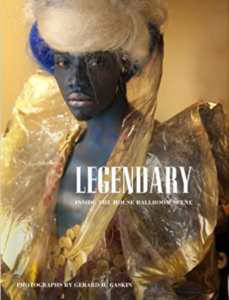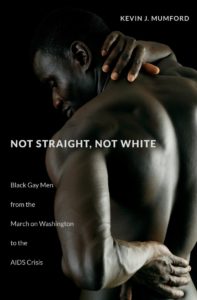Happy LGBTQ+ History Month!
This month, Emory Libraries is celebrating the experiences and histories of Black queer folks. Too often, the queer experience is reduced to the histories of white, cisgender men, leaving out other voices. The resources we have highlighted for this month, divided into Individual and Personal Perspectives and Academic and Ethnographic Perspectives, center the voices of Black LGBTQ+ authors, historians, and activists. These works tell histories of struggle, but also lift up community voices that push us towards a reckoning with the community’s past and possibilities for the future.
Individual and Personal Perspectives
Zami: A New Spelling of My Name
“ZAMI is a fast-moving chronicle. From the author’s vivid childhood memories in Harlem to her coming of age in the late 1950s, the nature of Audre Lorde’s work is cyclical. It especially relates the linkage of women who have shaped her . . . Lorde brings into play her craft of lush description and characterization. It keeps unfolding page after page.”—Off Our Backs
How We Fight For Our Lives:A Memoir
Publisher’s Description: ““Haunted and haunting, How We Fight for Our Lives is a stunning coming-of-age memoir about a young, black, gay man from the South as he fights to carve out a place for himself, within his family, within his country, within his own hopes, desires, and fears. Through a series of vignettes that chart a course across the American landscape, Jones draws readers into his boyhood and adolescence—into tumultuous relationships with his family, into passing flings with lovers, friends, and strangers. Each piece builds into a larger examination of race and queerness, power and vulnerability, love and grief: a portrait of what we all do for one another—and to one another—as we fight to become ourselves.”
Unapologetic: A Black, Queer, and Feminist Mandate for Radical Movements
Publisher’s Description: “Drawing on Black intellectual and grassroots organizing traditions, including the Haitian Revolution, the US civil rights movement, and LGBTQ rights and feminist movements, Unapologetic challenges all of us engaged in the social justice struggle to make the movement for Black liberation more radical, more queer, and more feminist. This book provides a vision for how social justice movements can become sharper and more effective through principled struggle, healing justice, and leadership development. It also offers a flexible model of what deeply effective organizing can be, anchored in the Chicago model of activism, which features long-term commitment, cultural sensitivity, creative strategizing, and multiple cross-group alliances. And Unapologetic provides a clear framework for activists committed to building transformative power, encouraging young people to see themselves as visionaries and leaders.”
No Ashes in the Fire: Coming of Age Black and Free in America
Publisher’s Description: “When Darnell Moore was fourteen, three boys from his neighborhood tried to set him on fire. They cornered him while he was walking home from school, harassed him because they thought he was gay, and poured a jug of gasoline on him. He escaped, but just barely. It wasn’t the last time he would face death. Three decades later, Moore is an award-winning writer, a leading Black Lives Matter activist, and an advocate for justice and liberation. In No Ashes in the Fire, he shares the journey taken by that scared, bullied teenager who not only survived, but found his calling. Moore’s transcendence over the myriad forces of repression that faced him is a testament to the grace and care of the people who loved him, and to his hometown, Camden, NJ, scarred and ignored but brimming with life. Moore reminds us that liberation is possible if we commit ourselves to fighting for it, and if we dream and create futures where those who survive on society’s edges can thrive.”
Publisher’s Description: “From the New York Times bestselling author of Bad Feminist: a searingly honest memoir of food, weight, self-image, and learning how to feed your hunger while taking care of yourself.”I ate and ate and ate in the hopes that if I made myself big, my body would be safe. I buried the girl I was because she ran into all kinds of trouble. I tried to erase every memory of her, but she is still there, somewhere. . . . I was trapped in my body, one that I barely recognized or understood, but at least I was safe.”In her phenomenally popular essays and long-running Tumblr blog, Roxane Gay has written with intimacy and sensitivity about food and body, using her own emotional and psychological struggles as a means of exploring our shared anxieties over pleasure, consumption, appearance, and health. As a woman who describes her own body as “wildly undisciplined,” Roxane understands the tension between desire and denial, between self-comfort and self-care. In Hunger, she explores her past—including the devastating act of violence that acted as a turning point in her young life—and brings readers along on her journey to understand and ultimately save herself.”
Redefining Realness: My Path to Womanhood, Identity, Love & So Much More
Publisher’s Description: “In a landmark book, an extraordinary young woman recounts her coming-of-age as a transgender teen–a deeply personal and empowering portrait of self-revelation, adversity, and heroism. In 2011, Marie Claire magazine published a profile of Janet Mock in which she publicly stepped forward for the first time as a trans woman. Since then, Mock has gone from covering the red carpet for People.com to advocating for all those who live within the shadows of society. Redefining Realness offers a bold new perspective on being young, multiracial, economically challenged, and transgender in America. Welcomed into the world as her parents’ firstborn son, Mock set out early on to be her own person–no simple feat for a young person like herself. She struggled as the smart, determined child in a deeply loving, yet ill-equipped family that lacked money, education, and resources. Mock had to navigate her way through her teen years without parental guidance but luckily with a few close friends and mentors she overcame extremely daunting hurdles. This powerful memoir follows Mock’s quest for identity, from her early gender conviction to a turbulent adolescence in Honolulu that found her transitioning through the halls of her school, self-medicating with hormones at fifteen, and flying across the world for sex reassignment surgery at just eighteen. A profound statement of affirmation from a courageous woman, Redefining Realness shows as never before what it means to be a woman today and how to be yourself when you don’t fit the mold created for you.”
Black Girl Dangerous: On Race, Queerness, Class and Gender
Publisher’s Description: “Mia McKenzie, creator of the enormously popular website Black Girl Dangerous, writes about race, queerness, class and gender in a concise, compelling voice filled at different times with humor, grief, rage, and joy. In this collection of her work from BGD (now available only in this book), McKenzie’s nuanced analysis of intersecting systems of oppression goes deep to reveal the complicated truths of a multiply-marginalized experience. McKenzie tackles the hardest questions of our time with clarity and courage, in language that is accessible to non-academics and academics alike. She is both fearless and vulnerable, demanding and accountable. Hers is a voice like no other.”
Academic and Ethnographic Perspectives
Black on Both Sides: A Racial History of Trans Identity Publisher’s Description: “The story of Christine Jorgensen, Americas first prominent transsexual, famously narrated trans embodiment in the postwar era. Her celebrity, however, has obscured other mid-century trans narratives-ones lived by African Americans such as Lucy Hicks Anderson and James McHarris. Their erasure from trans history masks the profound ways race has figured prominently in the construction and representation of transgender subjects. C. Riley Snorton identifies multiple intersections between blackness and transness from the mid-nineteenth century to present-day anti-black and anti-trans legislation and violence. Drawing on a deep and varied archive of materials-early sexological texts, fugitive slave narratives, Afro-modernist literature, sensationalist journalism, Hollywood films-Snorton attends to how slavery and the production of racialized gender provided the foundations for an understanding of gender as mutable. In tracing the twinned genealogies of blackness and transness, Snorton follows multiple trajectories, from the medical experiments conducted on enslaved black women by J. Marion Sims, the father of American gynecology, to the negation of blackness that makes transnormativity possible. Revealing instances of personal sovereignty among blacks living in the antebellum North that were mapped in terms of cross dressingand canonical black literary works that express black mens access to the female within, he concludes with a reading of the fate of Phillip DeVine, who was murdered alongside Brandon Teena in 1993, a fact omitted from the film Boys Dont Cry out of narrative convenience.”
Sisters in the Life: A History of Out African American Lesbian Media-Making
Publisher’s Description: “”From experimental shorts and webseries to Hollywood blockbusters and feminist porn, the work of African American lesbian filmmakers has made a powerful contribution to film history. But despite its importance, this work has gone largely unacknowledged by cinema historians and cultural critics. Assembling a range of interviews, essays, and conversations, Sisters in the Life tells a full story of African American lesbian media-making spanning three decades. In essays on filmmakers including Angela Robinson, Tina Mabry and Dee Rees, on the making of Cheryl Dunye’s The Watermelon Woman (1996), and in interviews with Coquie Hughes, Pamela Jennings, and others, the contributors center the voices of black lesbian media makers while underscoring their artistic influence and reach as well as the communities that support them. Sisters in the Life marks a crucial first step in narrating the history and importance of these compelling yet unsung artists.”
No Tea, No Shade: New Writings in Black Queer Studies
Publisher’s Description: “No Tea, No Shade brings together nineteen essays from the next generation of scholars, activists, and community leaders doing work on Black gender and sexuality. This collection’s contributors speak new truths about the Black queer experience while exemplifying the codification of Black queer studies as a rigorous and important field of study.”
Publisher’s Description: “A profound intellectual engagement with Afrofuturism and the philosophical questions of space and time.Queer Times, Black Futures considers the promises and pitfalls of imagination, technology, futurity, and liberation as they have persisted in and through racial capitalism. Kara Keeling explores how the speculative fictions of cinema, music, and literature that center black existence provide scenarios wherein we might imagine alternative worlds, queer and otherwise. In doing so, Keeling offers a sustained meditation on contemporary investments in futurity, speculation, and technology, paying particular attention to their significance to queer and black freedom.”
Publisher’s Description: “Toxic Silence: Race, Black Gender Identity, and Addressing the Violence against Black Transgender Women in Houston contributes to a growing body of transgender scholarship. This book examines the patriarchal and heteronormative frames within the black community and larger American society that advances the toxic masculinity which violently castigates and threatens the collective embodiment of black transgender women in the USA. Such scholarship is needed to shed more light on the transphobic violence and murders against this understudied group.Little is known about the societal and cultural issues and concerns affecting black transgender women and how their gender identity is met with systemic, institutional, and interpersonal roadblocks. During a time period in American history defined by Time Magazine as ‘The Transgender Tipping Point,’ black transgender women have emerged as social, cultural, and political subjects to advance our understanding of the lives of people who identify as a part of both the black and LGBTQIA communities. In the end, this book calls on the black community and culture to end the toxic silence and act instead as allies who are more accepting and inclusive of differing sexualities and gender identities in an effort to improve the generative power of black solidarity.”
Ezili’s Mirrors: Imagining Black Queer Genders Publisher’s Description: “From the dagger mistress Ezili Je Wouj and the gender-bending mermaid Lasiren to the beautiful femme queen Ezili Freda, the Ezili pantheon of Vodoun spirits represents the divine forces of love, sexuality, prosperity, pleasure, maternity, creativity, and fertility. And just as Ezili appears in different guises and characters, so too does Omise’eke Natasha Tinsley in her voice- and genre-shifting, exploratory book Ezili’s Mirrors. Drawing on her background as a literary critic as well as her quest to learn the lessons of her spiritual ancestors, Tinsley theorizes black Atlantic sexuality by tracing how contemporary queer Caribbean and African American writers and performers evoke Ezili. Tinsley shows how Ezili is manifest in the work and personal lives of singers Whitney Houston and Azealia Banks, novelists Nalo Hopkinson and Ana Lara, performers MilDred Gerestant and Sharon Bridgforth, and filmmakers Anne Lescot and Laurence Magloire—none of whom identify as Vodou practitioners. In so doing, Tinsley offers a model of queer black feminist theory that creates new possibilities for decolonizing queer studies.”
Butch Queens Up in Pumps Gender, Performance, and Ballroom Culture in Detroit
Publisher’s Description: “Butch Queens Up in Pumps examines Ballroom culture, in which inner-city LGBT individuals dress, dance, and vogue to compete for prizes and trophies. Participants are affiliated with a house, an alternative family structure typically named after haute couture designers and providing support to this diverse community. Marlon M. Bailey’s rich first-person performance ethnography of the Ballroom scene in Detroit examines Ballroom as a queer cultural formation that upsets dominant notions of gender, sexuality, kinship, and community.”
Legendary: Inside the House Ballroom Scene
Publisher’s Description: “Gerard H. Gaskin’s radiant color and black-and-white photographs take us inside the culture of house balls, underground events where gay and transgender men and women, mostly African American and Latino, come together to see and be seen. At balls, high-spirited late-night pageants, members of particular “houses”—the House of Blahnik, the House of Xtravaganza—”walk,” competing for trophies in categories based on costume, attitude, dance moves, and “realness.” In this exuberant world of artistry and self-fashioning, people often marginalized for being who they are can flaunt and celebrate their most vibrant, spectacular selves. From the quiet backstage, to the shimmering energies of the runway. to the electricity of the crowd, Gaskin’s photographs take us to the ball. Legendary, comprised of photos taken at events in the New York city area, Philadelphia, Richmond, and Washington, D.C., is a collaboration between Gaskin, a camera-laden outsider who has been attending balls for twenty years, and the house members who let him enter the intimate world of ball culture.”
Not Straight, Not White:Black Gay Men from the March on Washington to the AIDS Crisis
Publisher’s Description: “his compelling book recounts the history of black gay men from the 1950s to the 1990s, tracing how the major movements of the times–from civil rights to black power to gay liberation to AIDS activism–helped shape the cultural stigmas that surrounded race and homosexuality. In locating the rise of black gay identities in historical context, Kevin Mumford explores how activists, performers, and writers rebutted negative stereotypes and refused sexual objectification. Examining the lives of both famous and little-known black gay activists–from James Baldwin and Bayard Rustin to Joseph Beam and Brother Grant-Michael Fitzgerald–Mumford analyzes the ways in which movements for social change both inspired and marginalized black gay men. Drawing on an extensive archive of newspapers, pornography, and film, as well as government documents, organizational records, and personal papers, Mumford sheds new light on four volatile decades in the protracted battle of black gay men for affirmation and empowerment in the face of pervasive racism and homophobia.”
By Paige Crowl, Teaching and Learning Librarian, Oxford College Library (she/her) and Melissa Hackman, African Studies, Sociology & Development Studies Librarian, Robert W. Woodruff Library (she/her)

